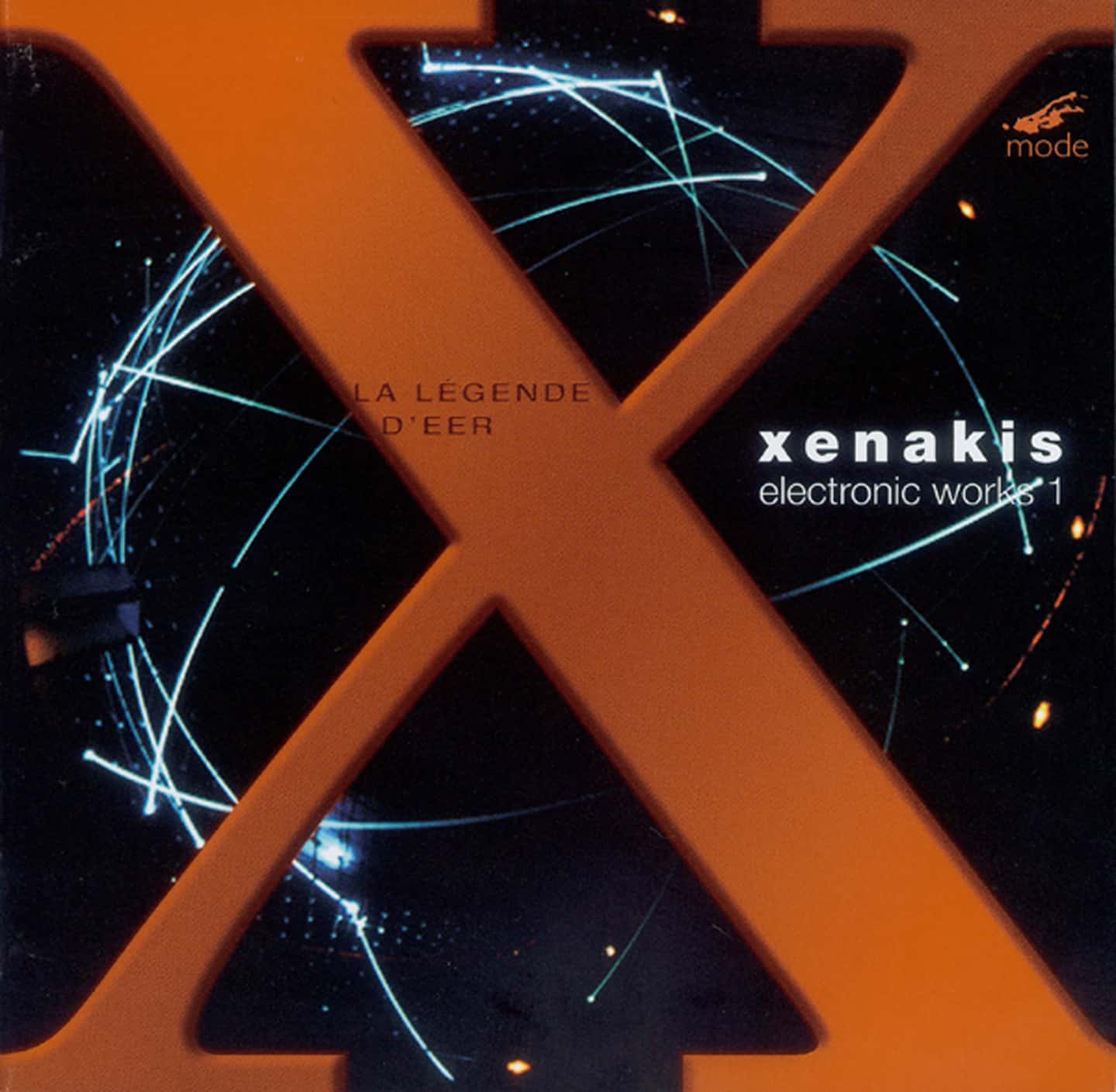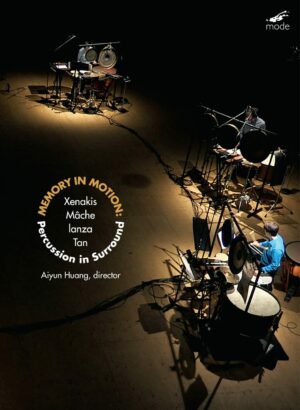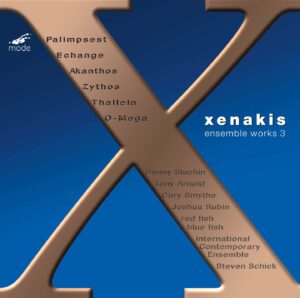Xenakis Edition 5–Electronic Works 1 - CD
La Légende d’Eer (1977-78) (47:04)
Electroacoustic Work for 7-channel tape
New stereo mix from the original master tape
master tapes by Gerard Pape
La légende d’Eer is a powerful 7-channel electro-acoustic composition which Xenakis created in 1977-78 to be played in “Le Diatope”, a curvaceous architectural construction designed by the composer, together with a visual component including laser lights. This “multi-media” work was composed for the opening of the Centre Georges Pompidou in Paris, where it was performed for three months and seen by thousands of people.
- The sound materials of a La légende d’Eer stem from three sources: instrumental sounds, noises, and electronically generated sounds. The work suggests an initial departure, a journey, and a final return. Xenakis surrounds the work with a compilation of five texts, reflecting or reacting upon each other across the distances in time, space, and culture which separate them.
- This new stereo mix was created by Gerard Pape – director of Xenakis’ CCMIX studio in Paris – from the original analog master tape.
- The analog master was transferred at high-resolution 96khz/24-bit sound for the optimum quality, revealing details not heard in the previous stereo CD release (now deleted).
- Use of the original master tape restored almost 2 minutes and 30 seconds to the piece, released here for the first time.
THE FIRST TIME XENAKIS’ MUSIC HAS APPEARED ON DVD.
SPECIAL DVD FEATURES:
- This new mix was created by Xenakis’ associate Gerard Pape from the original analog master tape, transferred at high-resolution 96khz/24-bit sound for the optimum quality.
- Use of the original master tape restored almost 2 minutes and 30 seconds to the piece, released here for the first time.
- The performance of La Légende d’Eer is shown with a film by Bruno Rastoin, comprised of 350 stills made during the original performance of the work at the “Diatope”. This is the ONLY visual documentation made of the historic event.
- 60-minute Interview of Iannis Xenakis by musicologist Harry Halbreich.
- 5.1 Surround Sound in Dolby Digital and additional DTS.
- Dedicated stereo mix presented in 96-khz/24-bit PCM.
- Subtitles: French, German, Spanish.
- Playable on ALL NTSC capable DVD decks and computers.
Reviews
Iannis Xenakis
La Legende d’Eer
CCMIX: New Electroacoustic Music From Paris
Mode 148
The music assembled for La Légende d’Eer was designed for the Polytope that Xenakis exhibited outside the Pompidou Centre in 1978. Mode’s DVD version attempts an interpretation of the visual and architectural material he intended to accompany the sounds, but the original structures themselves are now missing, presumed lost. His title is borrowed from Plato and the music itself conflates a typically diverse selection of sounds – various African and Japanese instruments, the sounds of bricks hit together – into wildly vibrant sonic matter. The static opening places simple melodic lines against extended durations, curiously Feldman-like in spirit, until Xenakis injects structural shocks into the unfolding argument.
CCMIX: New Electroacoustic Music From Paris documents the history of the UPIC computer based drawing tablet that Xenakis designed as a composition tool for both professional and amateur composers. The ideal of the system is that any shape made on the computer monitor can find its equivalent as a living sound object, therefore users don’t need to be fluent with conventional notation. His first work for the UPIC, Mycenae Alpha (1978), is heard alongside another Polytope, Polytope De Cluny. Music by Jean Claude-Risset, Julio Estrada, Curtis Roads and others demonstrates UPIC’s multifarious possibilities.
— Philip Clark, The Wire, July, 2006
Iannis Xenakis
La Legende d’Eer
Mode 148
Deep Ocean of Computer-Generated Sound, From 1978
The music of Iannis Xenakis can shuttle seamlessly between extremes: from ancient mythology to modern science, from the intensely visceral to the impossibly cerebral and from private insight to public spectacle. Few of his works spanned these poles as effectively as his landmark electro-acoustic tape piece, “La Légende d’Eer,” which was played on Thursday night at Anthology Film Archives. Written for the opening of the Georges Pompidou Center in Paris in 1978, “La Légende d’Eer” is a sweeping 45-minute work that takes its title from the myth of Er as recounted in Plato’s “Republic.” The music is a dense futuristic assembly of materials including non-Western percussion and constructed noise, and a dizzying array of computer-generated sound derived from Xenakis’s complex theories of probability.
But the composer, who was 78 when he died in Paris in 2001, was not content with stimulating the ears alone. For the Paris premiere, he and his colleagues built the “Diatope,” a large red curvy structure packed with flashing lights, 400 mirrors and four lasers. A program of texts was offered to aid in contemplation, ranging from the mythical tale of Er’s journey to the underworld, to philosophical reflections by Pascal and scientific writing about the luminosity of supernovas. Clearly this was an artistic vision that saw science as compatible with the numinous; a path to enlightenment charted with logarithmic functions.
In its day, “La Légende d’Eer” must have been an extraordinary spectacle. For those desiring at least a glimpse of what they missed, Mode Records has issued a DVD that offers a stereo mix of Xenakis’s original tape streamed over a series of Bruno Rastoin’s still photographs of the installation. The film was shown on Thursday night while the seven-channel tape piece, mixed live by the composer Gérard Pape, was played through large speakers placed around the theater.
From the outset, Xenakis’s music was harrowingly effective, tracing a broad arc of abstract sound and emotion, beginning and ending with high-pitched drones that hovered eerily in the darkness. The distribution of the speakers gave the music the desired sculptured quality and an almost tactile vividness. With Xenakis’s cosmic sound world surging on all sides, the film itself seemed almost superfluous, especially the portions that surveyed the physical construction of the Diatope, documenting a work at the same time that you were experiencing it.
Mode Records has also smartly issued a stand-alone audio CD of “La Légende,” and some may prefer this approach to the piece. The light show was cutting edge, but in the 1970’s. The music is more durable and plenty haunting on its own.
— Jeremy Eichler, New York Times, March 4, 2006
Iannis Xenakis
Electronic Music 1
La Légende d’Eer
Mode 148 (CD & DVD)
It is difficult to think of another contemporary composition which carries the sheer force of ‘The Legend of Eer.’ It is a gigantic, awesome, staggering piece; certainly I haven’t heard anything to touch it with electronic music’s short, if dense, history. The DVD-A version is forthcoming.
— Richard Scott, The Wire
Iannis Xenakis
Electronic Music 1
La Légende d’Eer
Mode 148 (CD & DVD)
Mode has released a wonderful new addition to its steadily growing output of new music DVDs; Xenakis Electronic Music 1 – La Légende d’Eer is volume five of its Xenakis series. The DVD contains a 67-minute video conversation of Xenakis with musicologist Harry Halbreich, two essays by Makis Solomos and Bruno Rastoin, the 47-minute electronic work La Légende d’Eer by Iannis Xenakis. La Légende d’Eer is accompanied by a “film” created by Bruno Rastoin; the film is a series of 350 images of Xenakis’ score for La Légende, diagrams of Le Diatope, and photographs of the original performance. (All of this comes with subtitles in English, German, French and Spanish.) La Légende was created for an elaborate production of lights, lasers, mirrors, and music to be performed in a curvilinear shell designed by Xenakis for the opening of the Centre Georges-Pompidou in Paris (a Xenakian gesamtkunstwerk!). La Légende d’Eer is presented here in surround sound. This mix, of the original Xenakis master tapes, was created by Gerard Pape of the Centre du Creation Musicale Iannis Xenakis.
The music of Iannis Xenakis can be grating on the nerves of any music lover, but the harsh worlds he creates in his works are also accompanied by incredible beauty and serenity (though some listeners do not give enough attention to Xenakis to find the beauty in his works). His electronic music is daring and exciting, La Légende d’Eer is an powerful epic work and it is not for the faint of heart. There is another recording of this work by the Montaigne/Naïve label which I do not like as much, (perhaps it is the surround sound aspect of the new Mode release that I like). The accompanying film is a rare glimpse of graphic scores and diagrams of the work created by Xenakis. When I first watched the interview I was disappointed. The lighting is very bad (the interviewer and Xenakis are ghostly white) and the interview was videotaped on what seemed like a bad camcorder. The first half of the interview was not particularly interesting to watch, apparently it was not interesting to be there either because it seemed Xenakis wasn’t paying much attention. The interviewer was trying hard to drag answers out of Xenakis. Some of Xenakis’ replies were rather scattered and hard to follow only to end with him asking the interviewer to repeat the question. But 30 minutes into the interview something changed. Xenakis must have woken up. Xenakis opened up. The last half of this interview is a wonderful glimpse into the working mind of Iannis Xenakis as his ideas on his music and modern art are expressed wonderfully. Any Xenaki-phile will enjoy this DVD.
— posted by Everette Minchew, Sequenza 21, June 16, 2005
Iannis Xenakis
La Légende d’Eer
Mode 148 (CD & DVD)
“Music is not a language. Any musical piece is akin to a boulder with complex forms, with striations and engraved designs atop and within, which men can decipher in a thousand different ways without ever finding the right answer or the best one,” wrote Iannis Xenakis in his introductory notes to the performance of his sound-light Diatope installation at the Pompidou Centre in 1978, for which he composed the seven-channel tape work La Légende d’Eer (after Plato). A few years ago, thanks to the no doubt well-intentioned but somewhat suspect attentions of DJ Spooky (amongst others), Xenakis’s music became, for a short while, radically hip, with a whole generation of noiseniks jumping into the back catalogue and claiming it as their own heritage, resulting in Asphodel’s opportunist and decidedly dodgy – in terms of both content and ideology – repackaging and remixing of Persepolis (of which the less said the better, lest I get any more gratuitously offensive email from Zbigniew Karkowski, who “curated” that project). But in their undoubtedly sincere enthusiasm for the composer’s work and its impenetrable, uncompromising soundworld (hardly surprising he should compare it to a boulder), they overlooked a crucial detail: Xenakis was first and foremost an architect, and the formal aspects of huge sprawling electronic works like Persepolis and La Légende d’Eer were worked out in meticulous detail and are as solid as a Gothic cathedral. This extraordinary sonic universe of thumb pianos, Jew’s harps, Japanese drums and bricks banged and rubbed against each other is as impressive as it is expressive, and impossible to ignore – it’s most definitely not background music, and its power to disturb can’t be removed just by turning the volume down – but what makes the 47-minute span of music so effective is the composer’s unerring precision in combining these “concrete” elements with his own computer-assisted electronic music in a superbly proportioned and aesthetically satisfying formal design. As always there’s plenty of additional information to be had, both in the accompanying booklet and on the DVD version (which includes Bruno Rastoin’s striking archive photographs of the original Diatope multimedia extravaganza, and an entertaining if rather woolly chat between Xenakis and Harry Halbreich), but it’s the music that matters most – when the Spookys, Karkowskis (and Warburtons) of this world are no more than footnotes in dusty back issues of old magazines, this extraordinary work will still be out there, blowing the hearts and minds of a whole new generation of musicians and non-musicians alike.
— Dan Warbuton, www.paristransatlantic.com, June 2005





